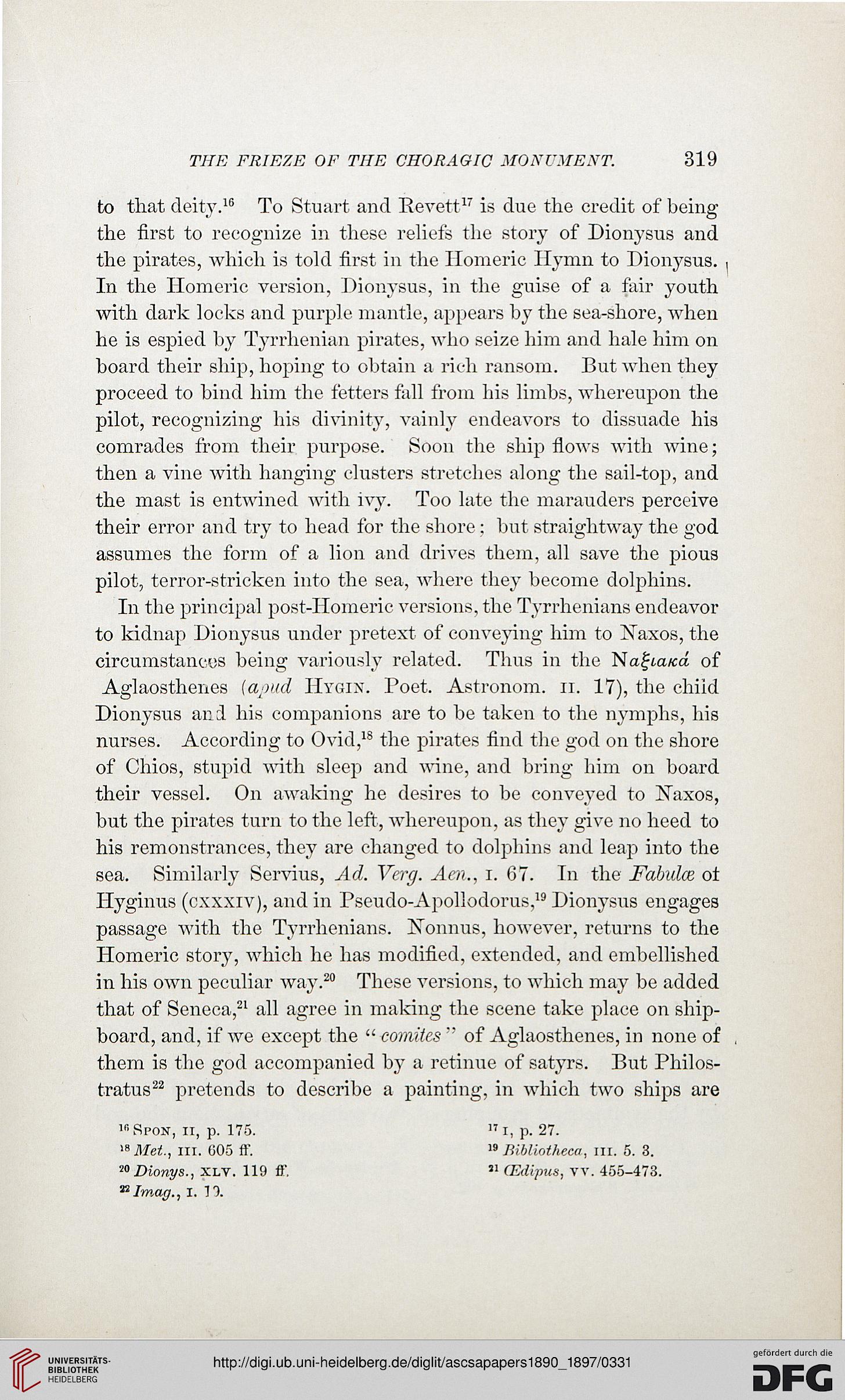THE FRIEZE OF THE CHORAGW MONUMENT.
319
to that deity.15 To Stuart and Revett17 is due the credit of being
the first to recognize in these reliefs the story of Dionysus and
the pirates, which is told first in the Homeric Hymn to Dionysus. ■
In the Homeric version, Dionysus, in the guise of a fair youth
with dark locks and purple mantle, appears by the sea-shore, when
he is espied by Tyrrhenian pirates, who seize him and hale him on
board their ship, hoping to obtain a rich ransom. But when they
proceed to bind him the fetters fall from his limbs, whereupon the
pilot, recognizing his divinity, vainly endeavors to dissuade his
comrades from their purpose. Soon the ship flows with wine;
then a vine with hanging clusters stretches along the sail-top, and
the mast is entwined with ivy. Too late the marauders perceive
their error and try to head for the shore; but straightway the god
assumes the form of a lion and drives them, all save the pious
pilot, terror-stricken into the sea, where they become dolphins.
In the principal post-Homeric versions, the Tyrrhenians endeavor
to kidnap Dionysus under pretext of conveying him to Naxos, the
circumstances being variously related. Thus in the Na^ta/ca of
Aglaosthenes (apud Hygix. Poet. Astronom. n. 17), the child
Dionysus an i his companions are to be taken to the nymphs, his
nurses. According to Ovid,18 the pirates find the god on the shore
of Chios, stupid with sleep and wine, and bring him on board
their vessel. On awaking he desires to be conveyed to Naxos,
but the pirates turn to the left, whereupon, as they give no heed to
his remonstrances, they are changed to dolphins and leap into the
sea. Similarly Servius, Ad. Verg. Acn., i. 67. In the Fabulce ot
Hyginus (cxxxiv), and in Pseudo-Apollodorus,19 Dionysus engages
passage with the Tyrrhenians. ISTonnus, however, returns to the
Homeric story, which he has modified, extended, and embellished
in his own peculiar way.20 These versions, to which may be added
that of Seneca,21 all agree in making the scene take place on ship-
board, and, if we except the " comites " of Aglaosthenes, in none of
them is the god accompanied by a retinue of satyrs. But Philos-
tratus22 pretends to describe a painting, in which two ships are
"■■Spon, ii, p. 175. "i, p. 27.
™Met., iii. 005 ff. 19 Ribliotheca, ta. 5. 3.
™Dionys., xlv. 119 fl'. " (Edipus, vv. 455-473.
KImag., i. 13.
319
to that deity.15 To Stuart and Revett17 is due the credit of being
the first to recognize in these reliefs the story of Dionysus and
the pirates, which is told first in the Homeric Hymn to Dionysus. ■
In the Homeric version, Dionysus, in the guise of a fair youth
with dark locks and purple mantle, appears by the sea-shore, when
he is espied by Tyrrhenian pirates, who seize him and hale him on
board their ship, hoping to obtain a rich ransom. But when they
proceed to bind him the fetters fall from his limbs, whereupon the
pilot, recognizing his divinity, vainly endeavors to dissuade his
comrades from their purpose. Soon the ship flows with wine;
then a vine with hanging clusters stretches along the sail-top, and
the mast is entwined with ivy. Too late the marauders perceive
their error and try to head for the shore; but straightway the god
assumes the form of a lion and drives them, all save the pious
pilot, terror-stricken into the sea, where they become dolphins.
In the principal post-Homeric versions, the Tyrrhenians endeavor
to kidnap Dionysus under pretext of conveying him to Naxos, the
circumstances being variously related. Thus in the Na^ta/ca of
Aglaosthenes (apud Hygix. Poet. Astronom. n. 17), the child
Dionysus an i his companions are to be taken to the nymphs, his
nurses. According to Ovid,18 the pirates find the god on the shore
of Chios, stupid with sleep and wine, and bring him on board
their vessel. On awaking he desires to be conveyed to Naxos,
but the pirates turn to the left, whereupon, as they give no heed to
his remonstrances, they are changed to dolphins and leap into the
sea. Similarly Servius, Ad. Verg. Acn., i. 67. In the Fabulce ot
Hyginus (cxxxiv), and in Pseudo-Apollodorus,19 Dionysus engages
passage with the Tyrrhenians. ISTonnus, however, returns to the
Homeric story, which he has modified, extended, and embellished
in his own peculiar way.20 These versions, to which may be added
that of Seneca,21 all agree in making the scene take place on ship-
board, and, if we except the " comites " of Aglaosthenes, in none of
them is the god accompanied by a retinue of satyrs. But Philos-
tratus22 pretends to describe a painting, in which two ships are
"■■Spon, ii, p. 175. "i, p. 27.
™Met., iii. 005 ff. 19 Ribliotheca, ta. 5. 3.
™Dionys., xlv. 119 fl'. " (Edipus, vv. 455-473.
KImag., i. 13.




